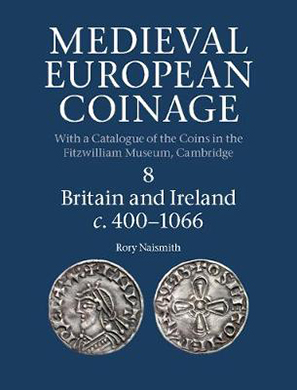by Ursula Kampmann
translated by Christina Schlögl
24 August 2017 – There aren’t many books I would deem an absolute “must” for every numismatic library. The MEC is one of them. MEC stands for Medieval European Coinage and every single volume is a kind of summary of the entire knowledge currently existing on medieval coins of a certain area. It consists of a comprehensive account of the current state of research as well as an illustrated catalogue, which can be used to classify every medieval coin. The MEC is a sort of basis work like the RIC or the Jaeger. If you have the MEC in your book shelf, no medieval coin will be left unclassified.
Rory Naismith, Medieval European Coinage, Band 8, Britain and Ireland c. 400-1066. Cambridge University Press, Cambridge 2017. Hardcover. Thread stitching. 866 p., 60 bw pl. 246 x 189 mm. ISBN-13: 9780521260169. 150 pounds.
At least, this applies to the areas already covered by the MEC. There are the Early Middle Ages, which was the first volume of the series, published in 1986. More than a decade later, volume 14 followed with coins of Southern Italy, Sicily and Sardinia. Five years later, volume 6 on the Iberian Peninsula was published. And in 2016 there were even two new releases: Volume 12 with Northern Italy, which we recently introduced in CoinsWeekly, and now volume 8 on the coins of Britain and Ireland, which covers the years between around 400 and 1066.
The work was published by Rory Naismith, who teaches medieval history of Britain at Cambridge. He is predominantly interested in the Anglo-Saxons and their neighbours. He specialises in coin, money and economic history, and he is particularly interested in contemporary charters and documents. In 2012, he published a book by the title Money and Power in Anglo-Saxon England: the Southern English Kingdoms 757-865, which was awarded the International Society of Anglo-Saxonists‘ Best First Book prize 2013. Is there more to say? The MEC-team has won a relatively young, but highly qualified author the publication.
This volume of the MEC is structured like all other volumes. It starts with a historic overview of the entire topic, which is succeeded by an overview on monetary history. Afterwards there are individual chapters that treat the coins chronologically and then according to territories and kingdoms. Every chapter is subdivided into a historic introduction, a survey of literature and a detailed description of the coinage with all scholarly questions.
The theoretical part proceeds the plate-part which lists all objects of the extensive Cambridge-collection, going back to Philip Grierson. The photos are much better and higher in contrast than those of the last volume. All details are visible this time. The descriptions are detailed as always.
What more is there to say about a book that actually need not be reviewed but simply bought? It is the equivalent of the black t-shirt inside every wardrobe – an essential to everyone who occasionally occupies themselves with medieval coins.
The newest MEC can be ordered for 150 pounds at Cambridge University Press.
By the way, Cambridge University Press also offers all other volumes of the MEC. If you have missed one, do not hesitate to order it at soon as possible.





